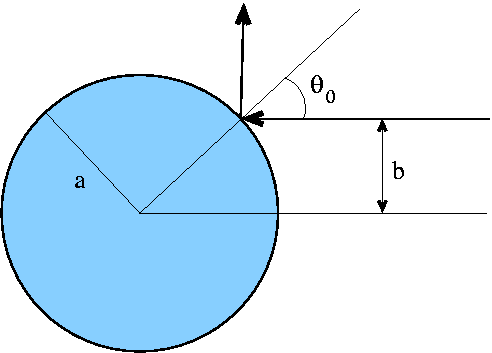CROSS SECTION IN CLASSICAL MECHANICS
To understand the concept of a cross section in classical mechanics first, consider the following situation: A beam of particles approaches the target under a certain impact parameter b. According to this impact parameter, dN of the particles are scattered into an angle interval [θ, θ+dθ] per unit time. To normalise, the number n of particles passing a unit area orthogonal to the direction of the beam per unit time is introduced. Then,
Assuming now that the realtion of b and θ is unambigously defined - as should be the case in (deterministic) classical mechanics, particles scattered into the angular interval [θ, θ+dθ] must have approched in the impact parameter interval [b(θ), b(θ+dθ)]. The number of such particles equals the product of n with the area of this ring, i.e.


EXAMPLE: SCATTERING OF ANOTHER PARTICLE AT REST
As a fist example, consider the scattering of a beam of incoming particles off an extended, massive particle with a fixed position. The expressions above remain valid, they yield the cross section in dependence of the scattering angle in the centre-of mass system. To find the expression in terms of the scattering angle in the laboratory system, some more work is needed.To formulate the problem in a more formal way, consdier the scattering of particles off an absolutely hard sphere with radius a, which takes n orecoil whatsoever. The interaction law is basically given by the potential U




CROSS SECTION IN QUANTUM MECHANICS
Consider now the scattering of incoming particles on some fixed target, the classical configuration. The cross section, usually denoted by σ, is defined as the transition rate per scatter seed in the target, per normalised incident flux of scatterers. The transition rate is the transition probability per unit time, hence



